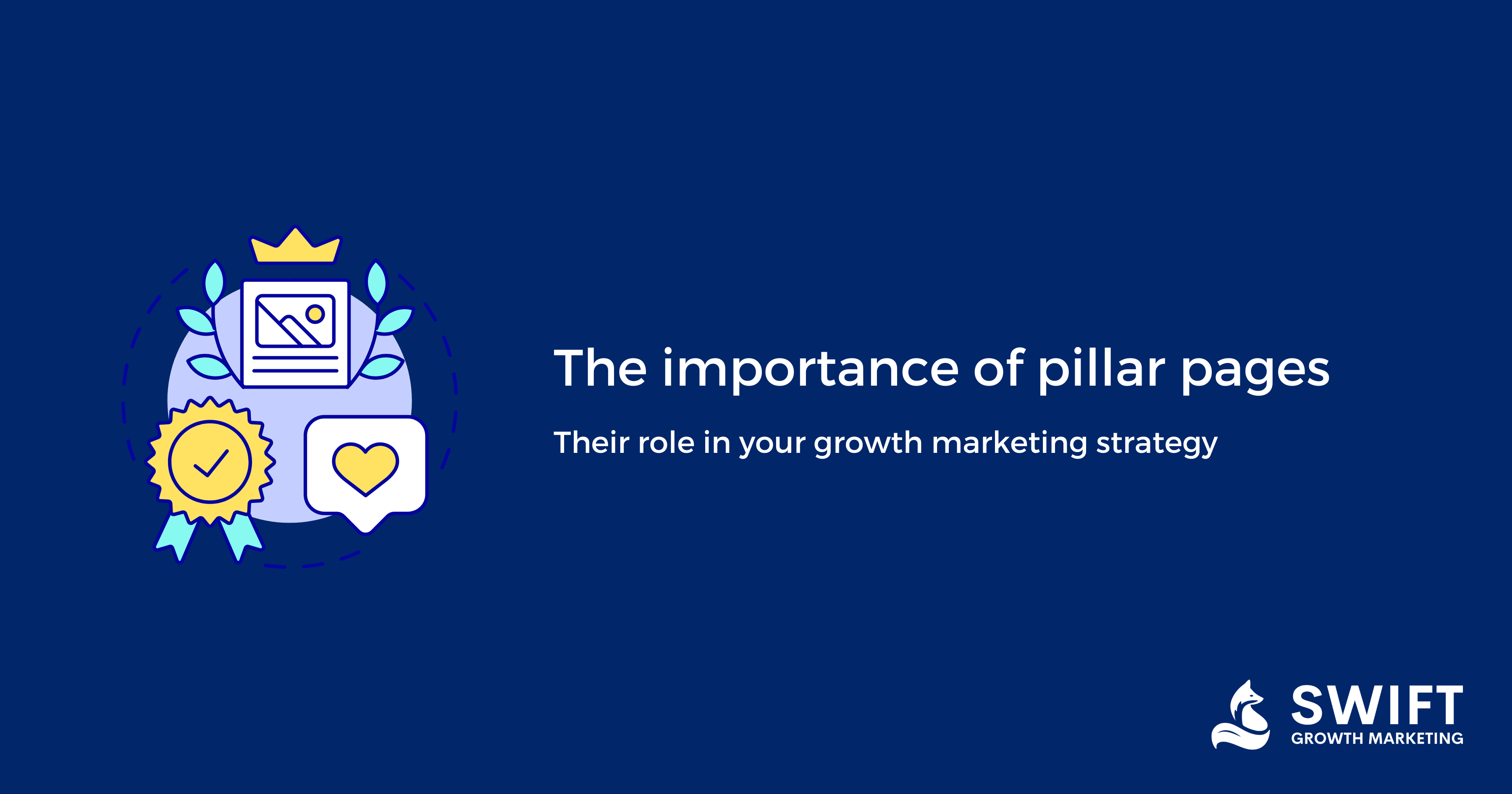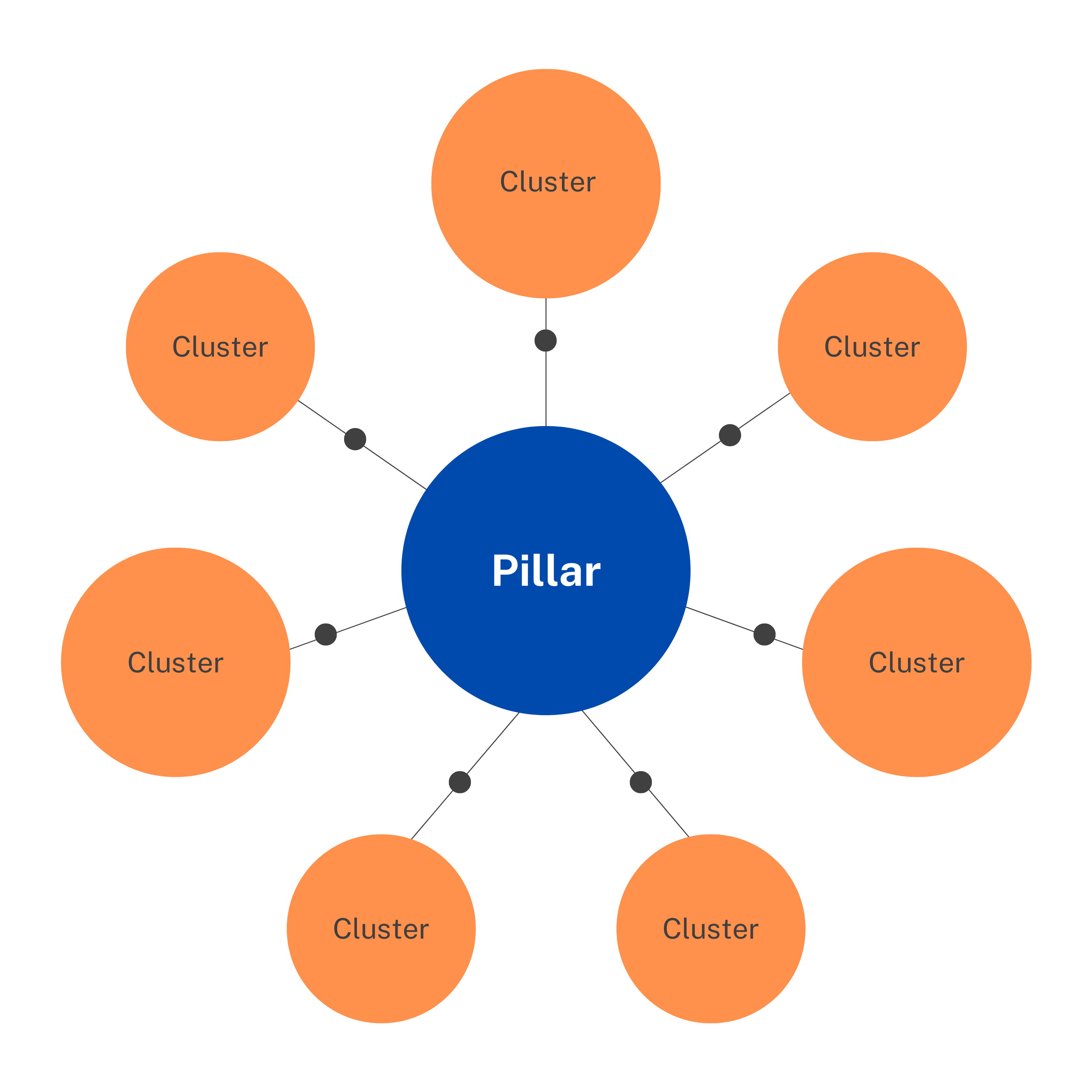
If you’ve been around the digital marketing niche long enough, you’ve probably heard the term “pillar pages” before, but what exactly are they? And how do you use them to boost your growth marketing strategy?
In this post, we’ll explain why pillar pages play a role in your growth marketing strategy and then show you how to create and optimize them for the best results.
A pillar page is a single page on your website that contains all of the information about one specific topic or product. It’s a powerful SEO tool because it helps search engines better understand your business and makes it easier for customers (and potential customers) to find quality information about your products or services.
Simply put, a pillar page is an extremely helpful piece of content around a specific subject. Since Google rolled out its helpful content update, it’s more important than ever to have pillar pages as part of your growth marketing strategy.
What is the purpose of a pillar page?

A pillar page is a central hub for a category of your website, meaning it should have a lot of content covering a specific category or topic in great detail. This page type is important for your growth marketing strategy because it will help you build a strong SEO foundation for that category or topic on a single page.
You want to ensure this type of page has many internal links from related content on your site and, ideally, quality external links (links coming in from other sites).
If your website is established and has relevant content you’ve already published, you should go back through and have those pages link to your new pillar page where it makes sense. If your website doesn’t have content related to that topic yet, then you should plan to create that content as part of your ongoing SEO strategy. Without supporting content, your pill page won’t be as effective. Blog posts that link back to your pillar pages are commonly referred to as cluster content. The goal of cluster content is to create a wide variety of pages that all link back to your pillar page. This helps Google understand that your site is dedicated to an important topic and will help boost the ranking power of your pillar page.
Pillar page vs. landing page
A landing page is a single page optimized for conversions. It usually has a high priority within your marketing or advertising strategy. It is designed to get people to take action, such as signing up for something or purchasing a product. A landing page can also be called a conversion or lead generation page.
On the other hand, a pillar page provides educational information about a specific topic or subject (i.e., how to clean your house). Pillar pages are important for SEO because they help build trust with visitors interested in what you’re offering but haven’t converted yet.
The main difference between a landing page and a pillar page is that the former is designed for conversions, while the latter provides educational content. In other words, your landing page will try to get people to sign up for something or buy a product; it’s the first step in your sales funnel. On the other hand, a pillar page provides helpful information to visitors who may be interested in what you have but haven’t converted yet.
Why pillar pages should be part of your growth strategy
Pillar pages are a vital component of your growth strategy. They help you build trust with your audience, create content that is 10x better than your competitors, and drive traffic to new and existing customers.
Pillar pages are not just for SEO; they’re also helpful in other areas of marketing, such as social media marketing, pay-per-click (PPC) ads, email marketing campaigns, etc.
Why do pillar pages boost SEO?
Pillar pages are an excellent tool for your SEO strategy, and they can help boost your website’s ranking on search engines and make it easier for people to find the information they need.
Pillar pages work well because Google works hard to ensure its users get relevant, quality results when searching for something. Google wants to know that each website on the internet has something useful or interesting to say about a particular topic instead of just being filled with random facts and details about nothing in particular or pages thin on content with little to no point.
When someone searches for specific topics, like “how do I choose an online marketing agency?” or “what are some things I need before starting my business?” Google wants them to come across websites with answers directly related to their questions! Rather than writing whatever comes to mind first (and then hoping people will find it), you’re more likely to rank high in search engine results when you write content focused on specific topics. This is because you provide your readers with what they are looking for: helpful information about the subject they are interested in!
What keywords should a pillar page target?
The topic of your pillar page should be a high-volume one, and the sub-topics should target lower-volume long-tail keywords.
The combination of pillar pages tackling high-volume head terms and blog posts or cluster content tackling low-volume long-tail keywords helps build your topic relevancy and authority.
For example, suppose your business sells yoga mats. In that case, you could have a pillar page that targets “yoga mats” with subheadings such as: “choosing a yoga mat,” “washing your yoga mat,” “yoga mat thickness guide,” and so on. You can turn these subheadings into blog posts that link back to your main pillar page, which links back to your homepage (which will connect to all the other pages on your site). This helps establish your site as an authority in the eyes of Google (and users).
What makes a good pillar page?
A good pillar page should meet the following criteria:
Be 10x better than average content
Good pillar pages are not just helpful or great content; they stand out from the rest of your content by being genuinely exceptional. If you were to measure them against a typical piece of writing and ask yourself, “How much better could this be?” you’d find that it would take a lot of work to make it even more helpful, relevant, informative, or well-written.
Be relevant to their topic and audience
Pillar pages are often used as part of an SEO strategy because they have high authority—they rank well in Google search results for one or more key terms (keywords). This means they must contain information specifically relevant to these terms, which means that pillar pages are valuable and actionable—it’s easy for someone who reads one to take something valuable away from it!
Leave the reader satisfied
Satisfy reader needs while providing value in exchange for time spent reading said content–both on-page factors like navigation & layout as well as off-page signals like citations & links demonstrate trustworthiness through word-of-mouth marketing which builds credibility when combined with social proof (elements such as social media shares) resulting in increased conversions over time because people recognize brand reputation through trusted sources like Amazon reviews
Should a pillar page be a blog post?
No. They are not the same thing, and you shouldn’t use your pillar pages as blog posts unless you don’t have any other option.
That said, blogs still play an essential role in your ongoing growth marketing strategy by linking to your pillar pages! For example, if your goal is getting more leads from Google search traffic, then writing blog posts that rank well in search engines and link directly to relevant content will help drive conversions while increasing awareness of the site itself.
How many pillar pages should you have?
There is no exact number of pillar pages, and it will depend on your niche, and we find that most brands can support at least 3 pillar pages. As you create more pillar pages and cluster content, you’ll likely uncover more opportunities for additional pillar pages.
To get started, consider your business’s core concepts or topics central to its identity. These are the pillars of your brand.
Pillar pages are the focal points for your content marketing strategy, so it’s essential to get them right. Here’s how to do it:
1) Determine which topics are most relevant to your product(s) or service(s).
2) Prioritize those topics by importance and relevance.
3) Create as many pillar pages as you need (3-5 should be enough).
4) Cluster related content around each pillar page.
If you’re unsure how many pillar pages you need, start with one pillar page and go from there. One of the most common mistakes made in growth marketing is waiting for the perfect answer. Instead of waiting, start creating!
Conclusion
Your pillar pages play a huge role in your growth marketing strategy. They provide you with the opportunity to create content that focuses on topics that interest your ideal customers and helps them understand more about your business and what it can offer them.
As we mentioned before, there are many different types of pillar pages that you can use for various purposes. Still, one thing remains constant: all of them should be authoritative and valuable for visitors who come across these pages at some point during their research process. By crafting these pages well enough (and having enough visitors visit them), they will be able to turn into something even more significant than just an informative resource – they will become assets!

